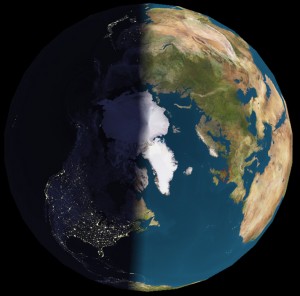The Significance of an Equinox
 This post has been timed for publication on the day and exact time of the Spring Equinox …
This post has been timed for publication on the day and exact time of the Spring Equinox …
The exact time of this cosmically significant event is 20th March at 11:02 UTC
From where I am sitting and where you are reading this blog, we are completely unaware of this twice yearly event – and why should we be? In our modern day world where we are totally in control, nothing as trivial as the orientation of the Earth could possibly have any effect on us … surely?
When viewed from space however, a different perspective emerges. We can see clearly that half the world is in darkness and half in light. Well there is nothing new there as it is like that every day of the year. The difference is that the cusp between light and dark is lined up with the rotational axis of the planet.
This means that every person on the planet experiences approximately the same amount of daylight and darkness, apart from those standing right on the Poles … and of course miners and submariners.
The exact time and day of the equinox, however, is not strictly that important. What is significant is that we should use it as a time for reflection. Too often our years just bleed into each other with each one following the pattern of the last. The fact that the Earth goes around in circles doesn’t mean we have to.
It doesn’t matter so much if there is any astrological or cosmological significance to the Equinox, just that every so often we should take stock and do some forward planning and, once we’ve done that, we should take action.
Spring is a great time to start a new project – for example, I’ve written all my books in Spring – something I only realised after I’d published the fourth book !
So for the last two months I have been planning and Mind Mapping my next book – today I start to write it in earnest !!
So, whether you are planning to write a book, or not, take some time out today to Spring Forward and so the seeds of what you are going to grow over the next 12 months.
Note, although the word equinox is often understood to mean “equal [day and] night”, this is not strictly true. For most locations on Earth, there are two distinct identifiable days per year when the length of day and night are closest to being equal; those days are referred to as the “equiluxes” to distinguish them from the equinoxes. Equinoxes are points in time when the Sun is right over the equator. Equiluxes are days which can be a couple of weeks either side and can vary depending where we are on the planet.
